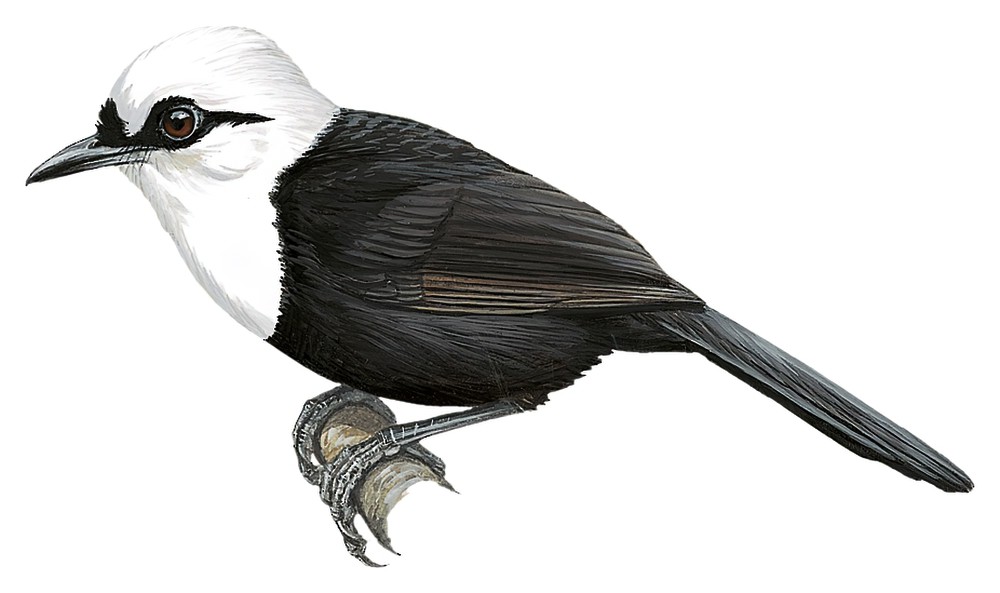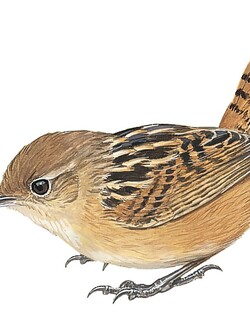Sumatran Laughingthrush / Garrulax bicolor

Sumatran Laughingthrush
SCI Name:
Protonym: G[arrulax]. bicolor Systemat.Verz.Nat.Samml.Ges.Mus. Abth. 1 p. 44, footnote
Taxonomy: Passeriformes / Leiothrichidae / Garrulax
Taxonomy Code: sumlau1
Type Locality: western Sumatra.
Author: Hartlaub
Publish Year: 1844
IUCN Status: Endangered
DEFINITIONS
GARRULAX
(Leiotrichidae; † White-crested Laughingthrush G. leucolophus belangeri) Genus Garrulus Brisson, 1760, jay; L. -ax inclining towards (cf. L. garrulus babbling < garrire to babble); from their noisy behavious the laughingthrushes were formerly known as jay-thrushes; "CII.e Le genre GARRULAXE; Garrulax, Lesson. ... Observ. Ce genre est très-distinct des geais et des merles, avec lesquels on a voulu associer les espèces qui le composent, et qui vivent dans l'Inde. Ce sont: 1.º Le GARRULAXE DE BÉLANGER; Garrulax Belangeri, Less., Zool. du Voy. aux Indes orientales, pl. 4 ... Cet oiseau est nommé weraôu par les habitans du Pégu, sa patrie. 2.º Le GARRULAXE A FRONT ROUX; Garrulax rufifrons, Less., Zool. du Voy. de Bélanger, pl. 5. ... De Java. 3.º Le GARRULAXE AZUR; Garrulax azureus. Less. ... Habite le Pégu." (Lesson 1831); "Garrulax Lesson, 1831 (June), Traité d'Orn.: 647. Type, by subsequent designation, Gray, 1846, Garrulax Belangeri Lesson, but nomen nudum, type hereby designated, Garrulax rufifrons Lesson." (Ripley, 1961, Synopsis Birds India Pakistan, p. 380); "GARRULAX Lesson, 1831 M— Garrulax belangeri Lesson, 1831; type by subsequent designation (G. R. Gray, 1855, Cat. of the Genera and Subgenera of Birds, p. 44)." (Dickinson and Christidis (eds.), H. & M. Complete Checklist, 4th ed., 2014, 2 (Passerines), p. 541).
Synon. Allocotops, Babax, Dryonastes, Garrulaxis, Ianthocincla, Kaznakowia, Leucodioptron, Melanocichla, Pterorhinus, Rhinocichla, Stactocichla.
bicolor
L. bicolor, bicoloris bicoloured < bi- two- < bis twice; color, coloris colour; epithet usually given to spp. with white underparts and contrastingly darker upperparts.
● ex “Crested Titmouse” of Catesby 1731, and “Mésange hupée de la Caroline” of Brisson 1760 (Baeolophus).
● ex “Coucal Noirou” of Levaillant 1807, pl. 220 (syn. Centropus nigrorufus).
● ex “Colibri Nr. 2” of Fermin 1769, “Saphir-émeraude” of de Buffon 1770-1783, and “Sapphire-and-Emerald Humming-bird” of Latham 1782 (Cyanophaia).
● ex “Pic varié de la Encénade” of d’Aubenton 1765-1781, pl. 748, fig.1, and “Encenada Woodpecker” of Latham 1782 (syn. Dendrocopos lignarius).
● ex “Pato roxo y negro” of de Azara 1802-1805, no. 436 (Dendrocygna).
● ex “Ramier blanc mangeur de muscade de la Nouvelle Guinée” of Sonnerat 1776 (Ducula).
● ex “Gobe-mouche à ventre blanc de Cayenne” of d’Aubenton 1765-1781, pl. 566, fig. 3, and de Buffon 1770-1786, and “Black and white Fly-catcher” of Edwards 1758, and Latham 1783 (syn. Fluvicola pica).
● ex "Merle brun du Cap de Bonne Espérance" of de Buffon 1770-1783, and "White-rumped Thrush" of Latham 1783 (Lamprotornis).
● ex "Bahama Sparrow" of Catesby 1731 (Melanospiza).
● ex “Petit Guêpier du Sénégal” of d’Aubenton 1765-1781, pl. 318 (?syn. Merops hirundineus).
● ex “Guêpier de l’isle de France” of d’Aubenton 1765-1781, pl. 252 (syn. Merops viridis).
● ex “Schet Noir” of Levaillant 1805, pl. 148 (syn. Terpsiphone mutata).
UPPERCASE: current genus
Uppercase first letter: generic synonym
● and ● See: generic homonyms
lowercase: species and subspecies
●: early names, variants, mispellings
‡: extinct
†: type species
Gr.: ancient Greek
L.: Latin
<: derived from
syn: synonym of
/: separates historical and modern geographic names
ex: based on
TL: type locality
OD: original diagnosis (genus) or original description (species)












